17 Types Of LARGE BIRDS In Arizona (ID Guide With Photos)
Did you recently come across a large bird in the state of Arizona, and want to know what species it was?
Identifying big birds in Arizona is not as easy as it might seem, since there are more than 20 bird species in the Grand Canyon State that are on the large side.
To help you identify the bird you saw, we’ll cover the most common large birds of Arizona in this article.
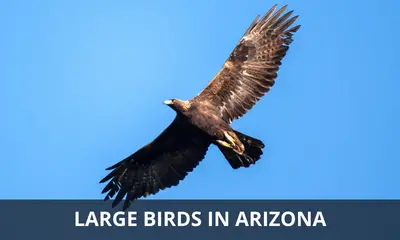
What are the types of large birds in Arizona?
The 17 types of large birds that can be seen in Arizona are:
- Great Egret
- Great Blue Heron
- Double-crested Cormorant
- American White Pelican
- Caspian Tern
- Snowy Egret
- Common Loon
- Osprey
- Bald Eagle
- Golden Eagle
- Turkey Vulture
- Great Horned Owl
- Red-tailed Hawk
- Swainson’s Hawk
- Common Raven
- Canada Goose
- Snow Goose
While many of these birds are year round residents of Arizona, others only occur in the state during the winter, as migratory birds that spend the cold months in Arizona.
Yet other birds are summer visitors during the breeding season, and some are scarce vagrants that are rarely seen in the state (more on that below).
Now let’s dive into the details, and take a closer look at each of these species in order to get the full scoop:
Great Egret
Scientific name: Ardea alba
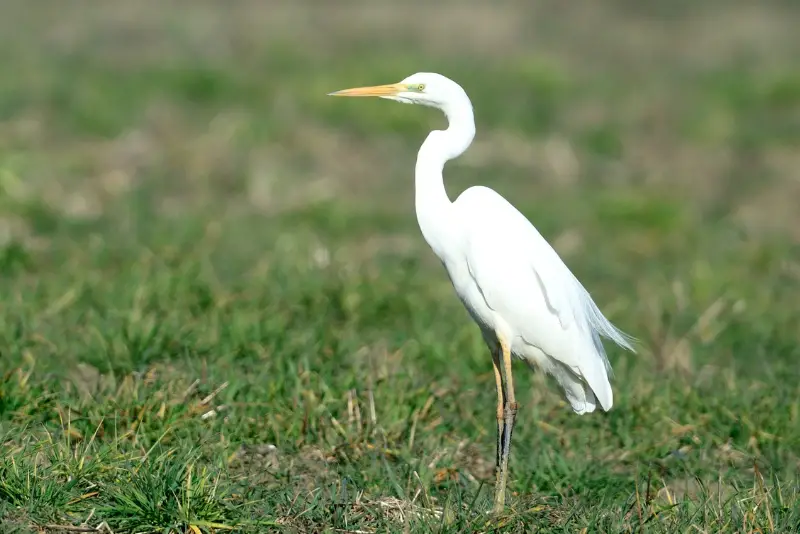
The Great Egret has a range that spans nearly the whole planet, and can be found on almost all continents.
In Arizona, this heron only breeds in the Colorado River valley, but can be seen on migration throughout the state. It also winters in southwestern Arizona.
One of Arizona’s biggest birds, this heron is entirely white, and has long black legs and feet as well as a thick, yellow bill.
During the spring and summer breeding seasons, the Great Egret grows a plume on its back that extends all the way to the tip of its tail.
It lives in both saltwater and freshwater habitats in Arizona, and often nests in large colonies on the banks of marshes, lakes, and rivers.
Great Egrets forage in any type of shallow water in Arizona, including ponds, lakes, rivers, estuaries, as well as rice fields and other flooded areas.
It is especially prevalent in the eastern and central regions of the state throughout the summer.
Outside of the breeding season it is less common, but where it occurs it can be seen in large flocks.
Great Blue Heron
Scientific name: Ardea herodias
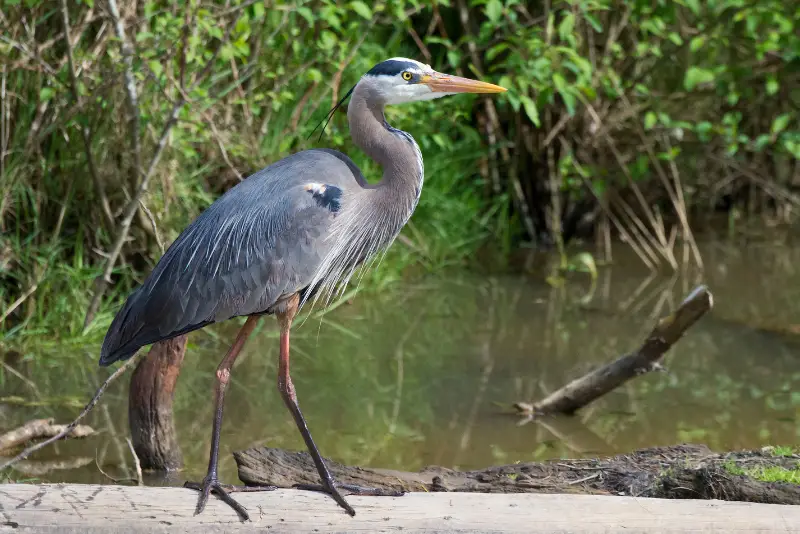
The Great Blue Heron is one of the most common herons in Arizona, where it can be seen year round.
With a wingspan of up to 6 feet, this heron is one of Arizona’s biggest birds. It is almost entirely blue gray, except for a white throat and eye stripe, as well as dark gray wing feathers.
This enormous blue bird in Arizona likes to hunt for small fish by wading in the shallows of estuaries, mud flats and marshes, as well as lake shores and small ponds.
It waits patiently for a suitably sized fish to come close enough to be grabbed with its long, yellow bill.
Double-crested Cormorant
Scientific name: Phalacrocorax auritus

The Double-crested Cormorant is a large, dark waterbird with a long neck and blue eyes. It is a year-round resident in Arizona, and is commonly found on coastal waters.
This cormorant likes to gather in large flocks that roost on trees close to water. It is a skilled diver and hunts fish with its large, hooked bill.
When a group of cormorants flies together, they like to form up in a V shaped formation.
Often these V-shaped formations can be seen in the evening, when the birds fly to their roosting spots in Arizona.
American White Pelican
Scientific name: Pelecanus erythrorhynchos
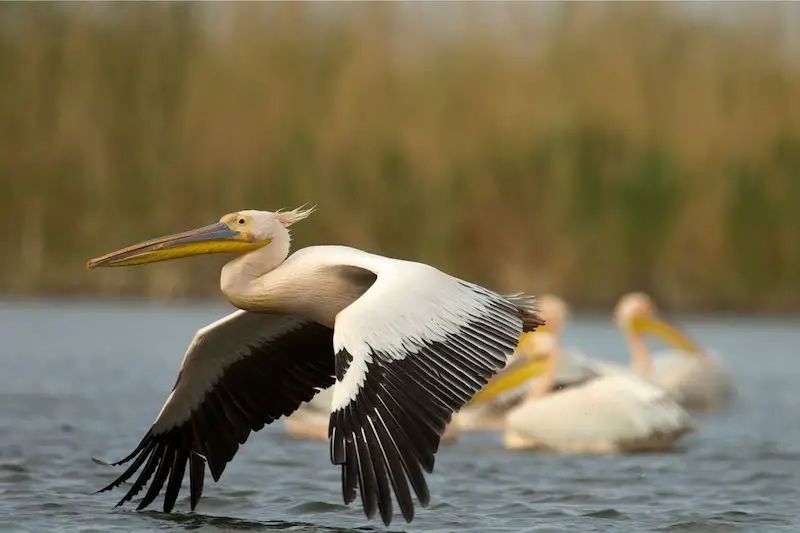
The American White Pelican is the biggest bird that can be seen in Arizona, and is a lot larger than the Bald Eagle.
American White Pelicans are increasingly observed in Arizona during the winter months, as they make Arizona their home during the cold season.
Previously these pelicans just stopped in Arizona for a brief pause before continuing to their wintering grounds further south, but in recent years more and more of them are choosing to spend the whole winter in Arizona.
Their preferred habitat in Arizona are reservoirs, river systems (such as the Colorado river), as well as smaller lakes and ponds throughout the state.
This huge bird is almost entirely white, except for black primary and secondary feathers on its wings.
Its huge beak is bright orange, and has a flat plate protruding from the upper part of the beak during the summer breeding season.
Outside of the breeding season, the bill changes its color from orange to pale yellowish.
This large water bird feeds almost exclusively on fish, but unlike other pelican species it doesn’t dive in order to catch them. Instead it submerges its head into the water, and grabs fish with its big beak.
American White Pelicans are most often seen in pairs or small groups that like to cooperate with each other while foraging for fish.
Caspian Tern
Scientific name: Hydroprogne caspia
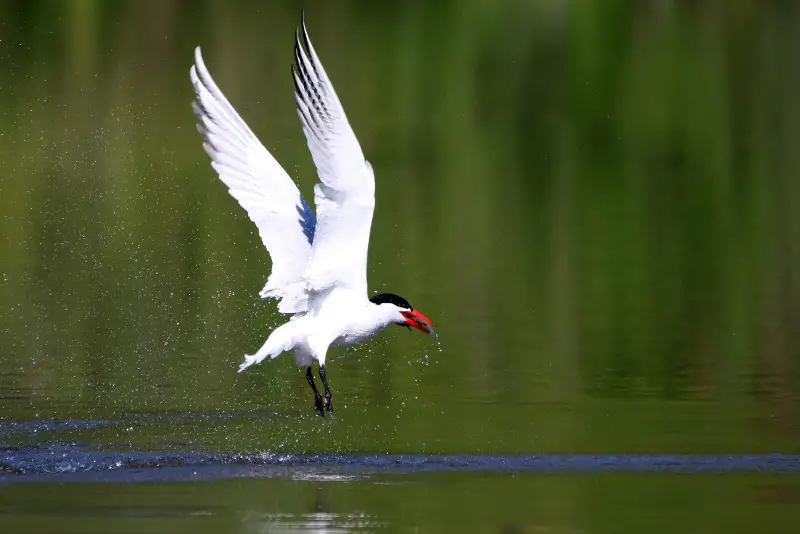
The Caspian tern is the largest tern species in the world, and a rare visitor in Arizona during migration.
It superficially resembles the Forster’s Tern, but it is a much bigger bird and has a thicker bill, broader wings, and a less forked tail.
Also, during winter the Caspian Tern doesn’t lose its black cap completely, but always retains a streaked, dark crown.
Forster’s Terns, on the other hand, lose their cap entirely during winter, which becomes completely white.
The Caspian Tern is not only a skilled hunter, but this bird also steals food from other terns and gulls. It catches fish by diving into the water with astonishing precision.
The Caspian Tern breeds in freshwater habitats in Canada and northern USA, and winters in the Caribbean and the Gulf of Mexico.
Snowy Egret
Scientific name: Egretta thula
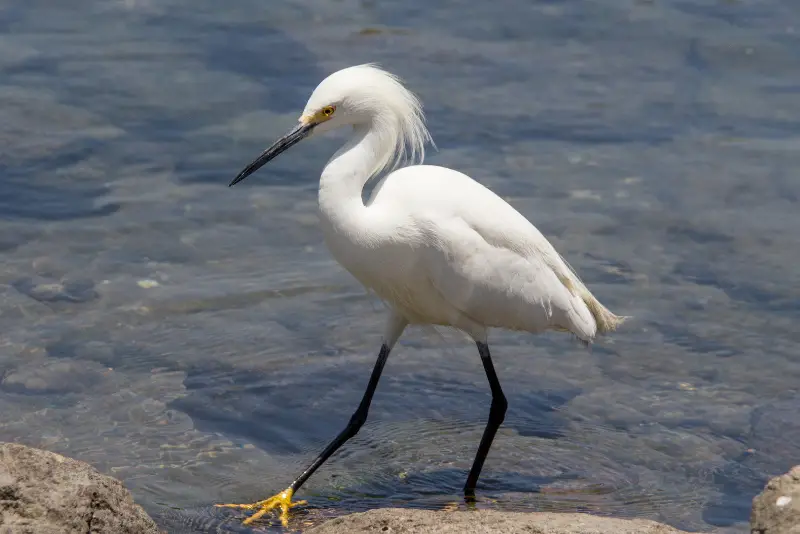
The Snowy Egret has become an increasingly common breeding bird in Arizona.
This is due to aggressive conservation efforts that were necessary because this Egret species was systematically hunted in previous centuries.
This white heron stands out due to its slim black bill and bright area between the eyes and nostrils. It has long legs and yellow feet, which distinguish it from other herons.
In adult birds, the feet are a brilliant golden yellow, while the legs are totally black. It is thought that the brightly colored feet help to attract small fish and other prey.
The legs of juvenile birds have a predominant greenish yellow color, with some black areas on the front of the leg.
It is found in practically all types of wetland environments, from small ponds to saltwater and everything in between.
During the summer, the Snowy Egret is a rare to relatively common breeding bird in the state.
It is much more common during the winter months, when large numbers can be observed in coastal Arizona.
Common Loon
Scientific name: Gavia immer
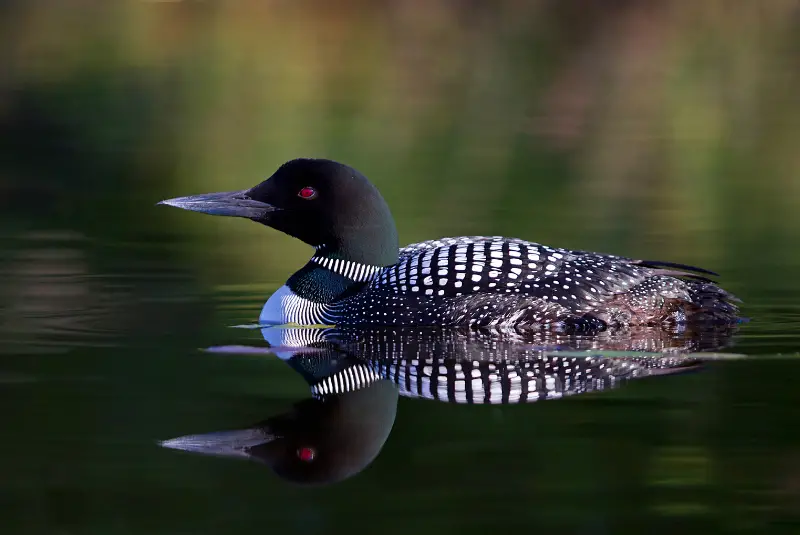
If you spotted a black waterbird with white dots, it is most likely the Common Loon (also known as the Great Northern Diver).
These water birds breed in northern areas of North America and can be seen along the coastline of Arizona during the winter.
They have big rounded heads with sharp beaks that resemble a dagger.
In the summer months, the birds have black heads, white chests, and lots of white spots on their black-colored plumage. In the winter or autumn months, their color dulls and turns into a pale gray.
The common loon is a fantastic diver and is super stealthy when it hunts underwater, allowing it to sneak up on fish without even a splash. It can dive to depths of up to two-hundred fifty feet.
To top that off, these birds can stay submerged for up to five minutes and even swallow their prey while they are still underwater.
They have a wingspan of between forty and fifty inches and can live for up to thirty years of age.
Osprey
Scientific name: Pandion haliaetus

The Osprey is one of the largest Arizona birds of prey, and with a wingspan of up to 69 inches (5 1/2 feet) it resembles an eagle in size.
It is usually easy to identify the Osprey due white belly and chest, which contrast with its blackish gray upperparts and black wrist patches on its lower wings.
This Arizona bird is the only raptor species that plunges into the water in order to catch fish, often becoming entirely submerged in water as it attempts to grab a fish with its feet.
Ospreys are almost always found close to water, except during migration, when they will cross areas without water.
The Osprey is a rare breeding bird and summer visitor in Arizona, where it can be found close to large river systems and reservoirs in central Arizona.
Outside of the breeding season, Ospreys can be observed on migration throughout Arizona, and a few of them winter in the southwestern part of the state.
Bald Eagle
Scientific name: Haliaeetus leucocephalus
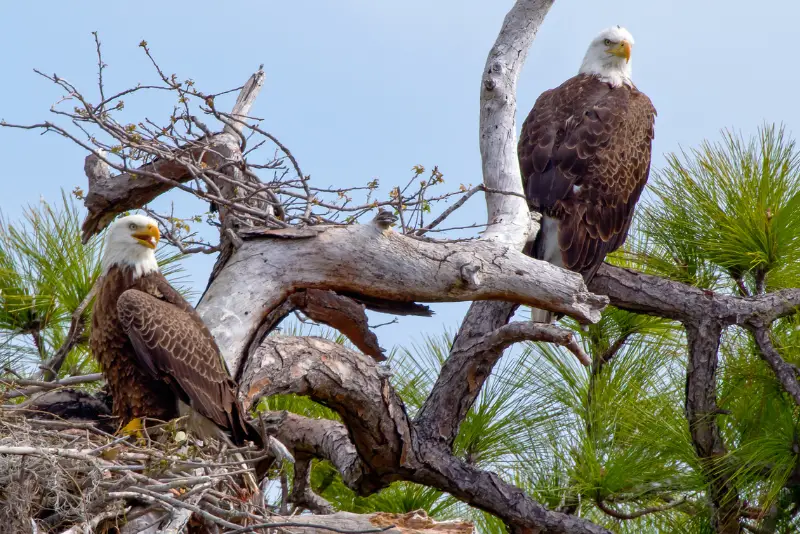
With a wingspan of up to 8 feet, the Bald Eagle is the largest bird of prey in Arizona.
In Arizona this large eagle nests along the Verde River and Salt River, and is also a regular breeding bird around the big man made reservoirs in Arizona.
Apart from its size, it is also one of the most easily recognizable birds in Arizona, due to its white head and tail, which contrast sharply with the uniformly dark brown body.
Juvenile birds are dark brown all over, with light irregular streaks all over the body, as well as a buff white belly.
Bald Eagles spend a lot of their time soaring on thermal currents with their wings held flat. They feed on fish, birds, and small mammals, although a big part of their diet consists of carrion.
Golden Eagle
Scientific name: Aquila chrysaetos
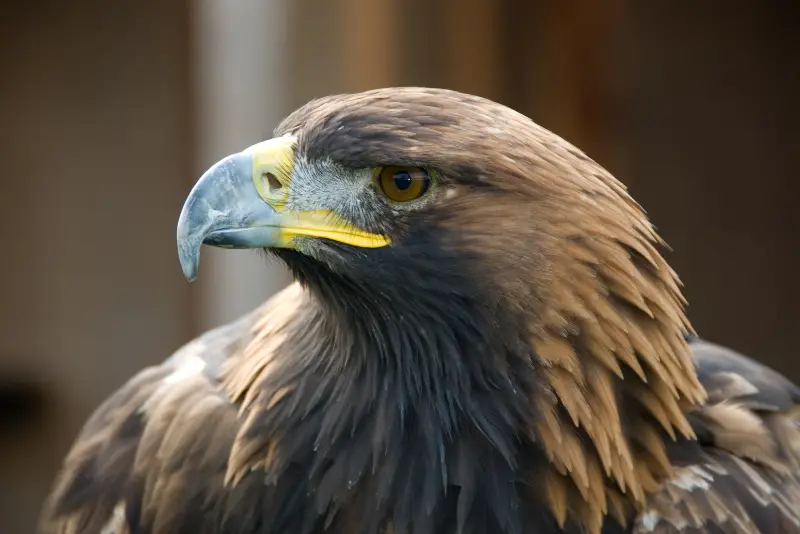
The Golden Eagle is one the most impressive eagle species in North America, and is a breeding bird in the western parts of the United States.
In the Grand Canyon State, the Golden Eagle is a regular breeding species that nests in montane habitats throughout Arizona.
Golden Eagles can be distinguished from Bald Eagles by their lack of white coloration on their heads.
The Golden Eagle is one of few circumglobal raptor species, and can be found in both the New World and the Old World.
Turkey Vulture
Scientific name: Cathartes aura
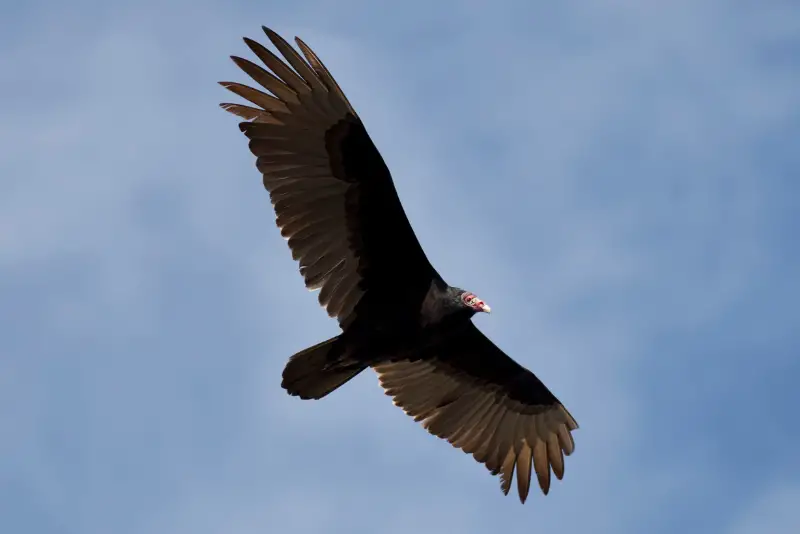
The Turkey Vulture is the largest vulture species in Arizona, and can reach a wingspan of up to 6 feet.
It is a big black raptor with a red head, and dark gray rear margins on their wings, which can be seen in flight.
A soaring Turkey Vulture is easily identifiable due to the fact that it holds its wings in an upright V shape.
This bird is a year-round resident throughout the Arizona peninsula, where it favors open country interspersed with woodland.
Similar to other vulture species in Arizona, this bird is specialized in feeding on carrion, and will often congregate in flocks around roadkill.
Great Horned Owl
Scientific name: Bubo virginianus

The Great Horned Owl is the largest owl species in Arizona, with a wingspan up to 4 feet. It is a large rufous brown bird with two horns and big bright yellow eyes.
In Arizona, this owl starts its nesting very early in the year, laying its eggs in January or February.
It is almost entirely nocturnal, and can hunt in complete darkness by relying on its keen sense of hearing.
The Great Horned Owl doesn’t build its own nest, but instead occupies the nests of other large birds, such as herons or raptors.
It is found year-round throughout Arizona, and can be found in a wide variety of habitats in Arizona, from woodlands to urban areas.
This owl is a fierce hunter, catching birds up to the size of ducks, and mammals up to the size of foxes.
Red-tailed Hawk
Scientific name: Buteo jamaicensis
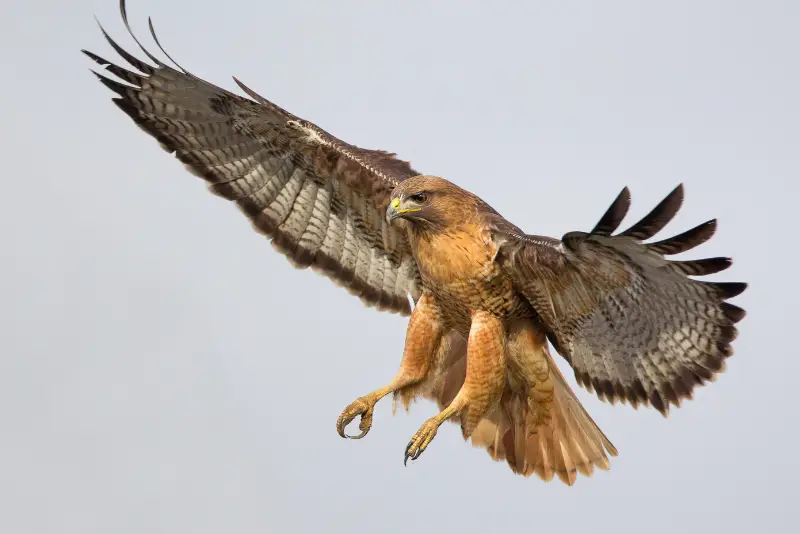
With a wingspan of up to 52 inches (4 1/2 feet), the Red-tailed Hawk is the largest hawk species in Arizona.
It has variable coloration, ranging from dark brown to almost entirely white, but can be readily recognized by its rusty red tail.
This large hawk is common in open areas and even in cities. It is most often seen perched on roadside posts or fences, waiting for prey.
The Red-tailed Hawk is one of the most common hawk species in Arizona, and can be seen in the Grand Canyon State year-round.
It feeds on rodents and other small animals that it catches by swooping down from its perch when they venture out into the open.
Swainson’s Hawk
Scientific name: Buteo swainsoni
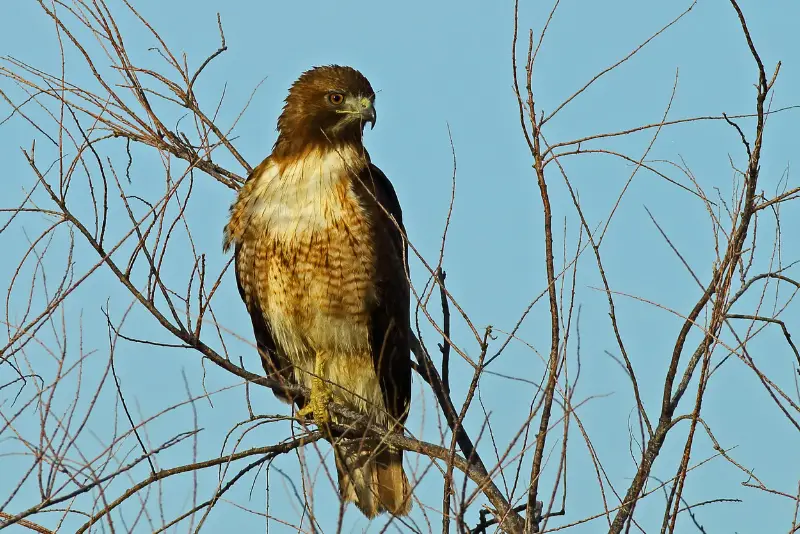
The Swainson’s Hawk is a large buteo that frequents dry prairies and open areas throughout Arizona during the summer months.
These hawks have long, narrow wings, and are best identified by their brown chest, which contrasts with the white underwings and chin.
Swainson’s Hawks are long distance migratory birds of prey that spend the winter in Argentina.
In fall they gather in flocks numbering in the tens of thousands that migrate south together, often together with other species, such as Broad-winged Hawks.
These common Arizona hawks can be seen in the Grand Canyon State from April through September.
Common Raven
Scientific name: Corvus corax

The Common Raven is a very large corvid, with a wingspan of up to 4.9 feet. In fact, it’s the largest songbird in North America.
Ravens mate for life, and an established pair will defend its territory all year round. As a result of this behavior, they are very rarely observed in flocks, which distinguishes them from other corvids.
The Common Raven is primarily found in the mountainous regions of Arizona in northern and western Arizona. Their preferred habitat is oak forest and mesquite shrubland.
Canada Goose
Scientific name: Branta canadensis

The Canada Goose is one of the most easily recognizable aquatic birds, due to its white cheeks that contrast with its jet black neck and head.
They are breeding birds in Canada and northern States, and fly south every fall in large V formations that herald the start of the cold season.
Canada Geese are winter visitors in northern Arizona that can be observed from October through April.
These Geese like to forage on grain fields after they have been harvested, and are sometimes seen together with Snow Geese.
Snow Goose
Scientific name: Anser caerulescens
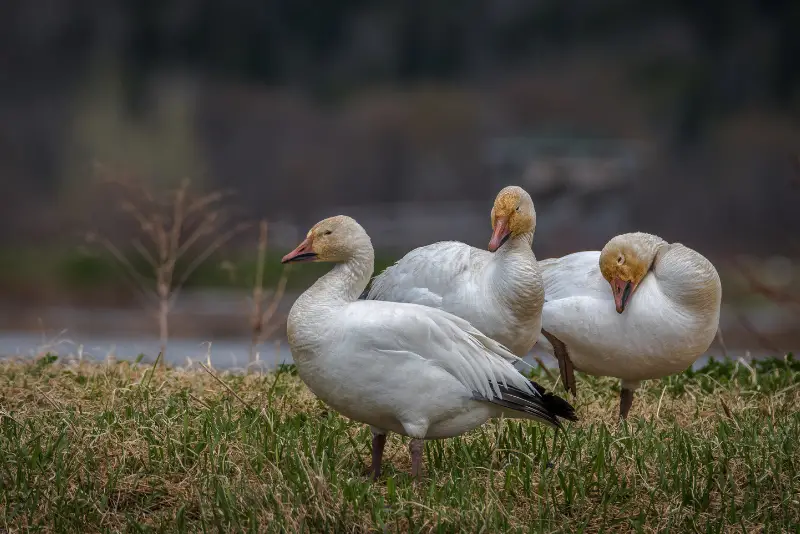
Snow Geese are scarce winter visitors in western Arizona, but the number of wintering Snow Geese has gradually increased in recent years.
The Snow Goose exists in two color morphs, one of which is entirely white, while the other is blue gray with a white-colored head.
The Arctic population of Snow Geese has gone up significantly in the past few decades, and as result it is also much more common in its wintering grounds.
Snow Geese like to feed on harvested farmland, such as wheat fields, where they feed on leftover grains. In some cases they also forage on rice fields.
Wintering Snow Geese can be seen in the westernmost region of Arizona. These birds arrive in October, and most of them leave by March.
What are the large black birds in Arizona?
The large black birds found in Arizona are Turkey Vultures, which have a wingspan up to 6 feet.
These black-colored vultures are commonly seen in Arizona soaring on thermal currents, or gathering in small groups at roadkill sites.
Another Arizona bird that’s large and black is the Common Raven, which is a rare breeding bird in the mountainous areas of west and central Arizona.
What is the largest bird in Arizona?
The largest bird in Arizona is the American White Pelican, which has a wingspan of up to 10 feet (120 inches) and a weight of up to 30 lb. It also has a huge beak, measuring up to 15 inches in length.
In spite of its large body weight, the American White Pelican is able to soar effortlessly on thermal currents, due to the enormous length of its wings.
These birds can be seen as regular winter visitors at lakes and ponds throughout Arizona, where they can be observed foraging for fish in pairs or small groups.
If you enjoyed this article, check out our guide to the yellow birds in Arizona.
